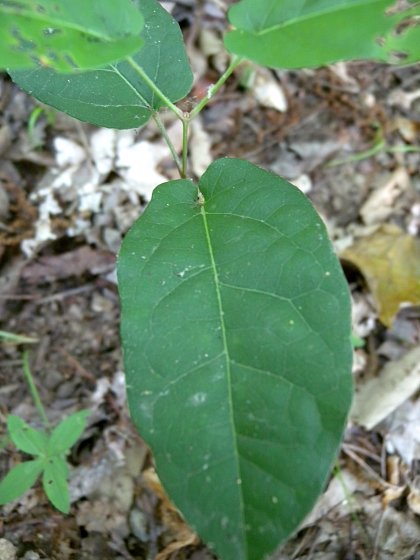
Cultivation: The preference is light to medium shade, mesic conditions, and a loamy soil with decaying organic matter (e.g., fallen leaves). As the flowers are not conspicuous, this is primarily a foliage plant for shade gardens or restoration of woodland habitat.
Range & Habitat: The native Virginia Snakeroot is uncommon to occasional in most areas of Illinois, except in the NW section of the state, where it is absent (see Distribution Map). The typical variety of this plant (Aristolochia serpentaria serpentaria) occurs in all of the areas that are indicated, while the narrow-leaved variety (Aristolochia serpentaria hastata) is restricted to the southern tip of Illinois, where it is rare. Illinois lies near the northern range-limit of this plant. Habitats include rich mesic woodlands, upland rocky woodlands, wooded slopes, and wooded ravines. This is a conservative species that is normally found in higher quality woodlands where the original ground flora is intact. It usually occurs in the forest understory as scattered solitary plants, rather than in colonies.
Faunal Associations: The odd-looking flowers are cross-pollinated primarily by flesh flies, fungus gnats, and possibly carrion beetles. After entering the flowers, these insects remain trapped in the calyx tube until the stamens mature, after which they escape carrying some of the pollen on their bodies. The floral reward of these insects is primarily nectar. The caterpillars of a butterfly, the Pipevine Swallowtail (Battus philenor), feed on the foliage of Virginia Snakeroot (Aristolochia serpentaria), although more than one plant is required to complete their development. Because the foliage and roots are toxic and unpleasant-tasting, mammalian herbivores do not feed on this plant. The method of seed dispersal for this plant is something of a mystery, although it has been speculated that small rodents may carry the the seeds to caches, where they are eaten as food. Because such rodents have short life spans, not all of the seeds are eaten (Allard, 2002).

Photographic Location: A woodland in southern Illinois. The photographed plant is an example of the typical variety, or Aristolochia serpentaria serpentaria.
Comments: It is possible to identify Virginia Snakeroot (Aristolochia serpentaria) by the shape of its leaves and its relatively low stature. The flowers of this plant resemble those of Woolly Pipevine (Aristolochia tomentosa) and Dutchman's Pipe (Aristolochia macrophylla), although the flowers of Virginia Snakeroot are smaller in size and they are held much closer to the ground. The latter two plants are much longer vines that are distributed primarily in SE United States, although Woolly Pipevine also occurs as a native plant in the southern tip of Illinois. These two vines are also cultivated occasionally. Some authors have assigned Virginia Snakeroot to the Endodeca genus, although this classification is not universally accepted. For example, Mohlenbrock (2014) refers to the typical variety of this plant as Endodeca serpentaria, while the narrow-leaved variety is referred to as Endodeca hastata. There is also disagreement about whether or not plants with narrow leaves are worthy of status as a variety or a distinct species.